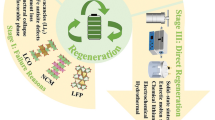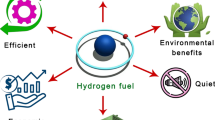The class of porous conducting composites and subclass of gas-diffusion layers (GDL) were analyzed as systems. The scheme for a systemic approach to designing GDL is presented. The triunity of the creative process is noted, including the methodical design of articles made of composites. The possibility of using systemic design methods for creating porous conducting composites to fabricate GDL for fuel cells. Ways of resolving the contradictory requirements for functioning of GDL are demonstrated. Examples of basic GDL designs are reported. Mathematical substantiation of the practical possibility of systemic design and fabrication of a number of basic GDL designs are presented. A classification of GDL based on consideration of the reciprocal spatial position of the direction of physical flows in GDL and the direction of formation of the structure of the GDL was developed.
Similar content being viewed by others
References
U. S. Department of Energy, Hydrogen Program. http://www.hydrogen.energy.gov/annual progress07 fuelcells.html 2007, Ann. Progr. Rep. V Fuel Cell, P. 278, 700, 680, 1281.
Development of two-phase flow simulation, Ann. Rep. 2006. http://www.mech.kyushu-u.ac.jp/lab/ki06/index.html.
T. Hottinen and O. Himanen, Electrochem. Commun., 9, No. 5, 1047-1052 (2007).
P. K. Sinha, P. P. Mikherjee, and C. Y. Wang, J. Mater. Chem., 17, 3089-3103 (2007).
J. V. Cole and A. Gidwani, Water Transport in PEM Fuel Cells: Advanced Modeling, Material Selection, Testing, and Design Optimization, prepared for: DOE Hydrogen Fuel Cell Kickoff Meeting February 13, 2007. http://www1.eere.energy.gov/hydrogen and fuelcells/pdfs/new fc cole cfd.pdf.
V. A. Lysenko, “Information model of design,” in: Proceedings of the XI St. Petersburg International Conference Regional Informatics-2008 (RI-2008), October 2224, 2008 [in Russian], SPOISU, St. Petersburg (2008), p. 289.
V. A. Lysenko, Khim. Volokna, No. 3, 44-50 )2008).
S. B. Perakath et al., IDEF5 Method Report, Knowledge-Based Systems, Inc. (1994), http://www.idef.com/pdf/Idef5.pdf.
V. A. Lysenko, A. A. Lysenko, and P. Yu. Sal’nikova, “Optimization of the properties of carbon-fibre porous conducting layers for fuel cells,” in: Current Trends in the Evolution of the Chemistry and Engineering of Polymer Materials, Proceedings of the International Conference Dedicated to the 70th Anniversary of the Faculty of Applied Chemistry and Ecology, St. Petersburg, November 24-26, 2008 [in Russian], SPGUTD, St. Petersburg (2008), pp. 22-23.
V. Schulz, D. Kehrwald, et al., “Flow, heat conductivity, and gas diffusion in partly saturated microstructures, http://www.itwm.fraunhofer.de/sks/employees/wiegmann/References/NAFEMS_schulzvo.pdf.
Toray. http://www.toray.com.
Author information
Authors and Affiliations
Additional information
Translated from Khimicheskie Volokna, No. 5, pp. 38-43, September-October, 2009.
Rights and permissions
About this article
Cite this article
Lysenko, V.A. Principles for designing conducting composites for fuel cells. Fibre Chem 41, 321–327 (2009). https://doi.org/10.1007/s10692-010-9197-8
Published:
Issue Date:
DOI: https://doi.org/10.1007/s10692-010-9197-8




